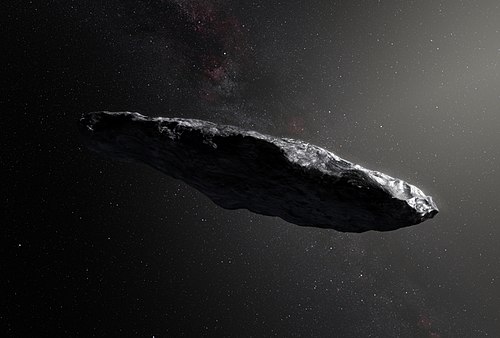
On October 17, 2017, the field of astronomy bore witness to an extraordinary event when the very first interstellar object, named 1I/ʻOumuamua, was discovered by astronomers. This discovery garnered global interest and opened new perspectives on the study of objects originating from other stellar systems. In addition to its scientific significance, this discovery also triggered speculations about an artificial origin, fueling the debate on the possibility of extraterrestrial life.
On October 17, 2017, astronomer Robert Weryk spotted a rapidly moving object through the solar system using the Pan-STARRS1 telescope in Hawaii. The unusual characteristics of this object immediately caught the attention of the scientific community. Measuring approximately 800 meters long and only 80 meters wide, ʻOumuamua had an elongated shape and exhibited a trajectory that clearly indicated it did not originate from our solar system.
Hypothesis of an Artificial Origin
One of the most intriguing hypotheses that emerged regarding ʻOumuamua is that of an artificial origin. To explore this possibility, the Search for Extraterrestrial Intelligence (SETI) program initiated in-depth studies of the object using two renowned radio telescopes: the Green Bank Telescope and the Allen Telescope Array, as part of the Breakthrough Listen project. The aim was to detect any unusual radio emissions that might suggest ʻOumuamua is, in fact, an interstellar spacecraft.
This hypothesis garnered significant media and public interest, leading to numerous speculations about extraterrestrial life. However, despite extensive efforts, no unusual radio emissions were detected. This prompted the scientific community to continue exploring alternative explanations.
Another intriguing hypothesis arose from the observation of ʻOumuamua's trajectory. In addition to being influenced by gravity, the object appeared to be subject to an unidentified force. Moreover, no outgassing was observed, leading physicists Shmuel Bialy and Abraham Loeb to hypothesize that the object might be sensitive to solar radiation pressure. This idea suggested that ʻOumuamua could be some form of solar sail, a potential technology of artificial origin designed for interstellar navigation.
However, it is crucial to note that these hypotheses of artificial origin remain highly debated and are not universally accepted among scientists. More conventional explanations have been proposed, including the notion that ʻOumuamua's elongated shape could cause uneven thermal emissions, or that outgassing may have occurred but remained undetectable due to specific conditions.
In summary, the discovery of 1I/ʻOumuamua in 2017 marked a significant turning point in the study of interstellar objects. This swift visit from an interstellar guest stirred excitement among astronomers and the public while fueling fascinating scientific debates about its origin, whether natural or artificial. Regardless, ʻOumuamua will continue to be a subject of ongoing study and speculation for scientists and astronomy enthusiasts worldwide.
Askaniy, CC BY 4.0, https://commons.wikimedia.org/wiki/File:Eso1737e.jpg


0 comments: